Taiwan: Not Quite China
- Aaron Schorr
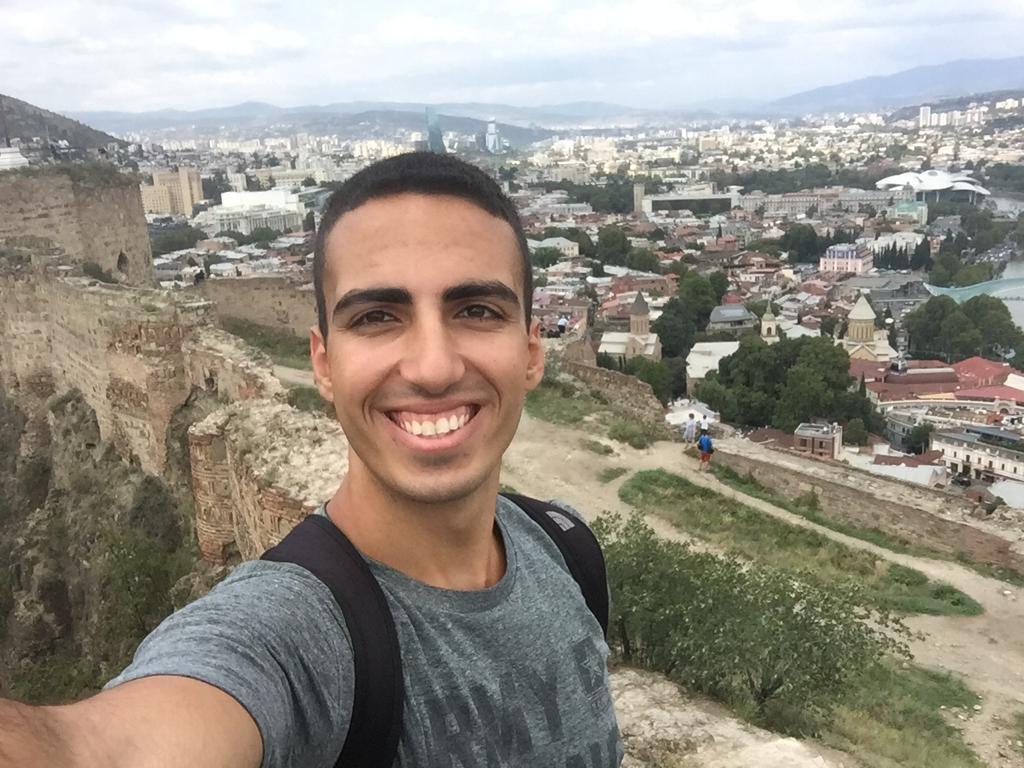
- Mar 15, 2020
- 18 min read
My apologies for taking so long to post. Getting a stable Internet connection has been a challenge over the past few days and with more and more obstacles created by COVID-19 it's been hard to find time to write.
The mechanical issues were magically fixed and we boarded the plane, a horribly cramped A330 the Malaysian airline thought could fit 9 passengers across, but they must have been using some very small Malaysians for their measurements. Our destination was Taipei, Taiwan, a rather spontaneous decision made in Kyoto due to - what else? - the coronavirus outbreak. Worsening conditions in South Korea, which itself had been a backup plan after China became a non-option, meant we couldn't go there as we had planned. Things were changing rapidly in the world of international travel and we had to adapt accordingly. Getting out of Japan without being able to connect through China or Korea made our options rather limited, and Taiwan seemed to hold a lot of promise for adventurous fun. We landed 2 hours and 45 minutes late, an extremely frustrating number since delays of under 3 hours weren't eligible for compensation, meaning I had lost quite a bit of sleep with nothing to show for it.

We signed a form saying we hadn't been to China, Hong Kong, South Korea, or Italy recently, had our temperatures and fingerprints taken, and were stamped into Taiwan, officially the Republic of China, perhaps not the most advantageous stamp to have in one's passport these days. A bus ride on some deserted highways brought us to the main train station, which was walking distance from our hotel. Yes, hotel. Crashing hotel prices due to the lack of tourists meant we could afford to stay at a hotel for the price of two dorm beds. Yes, the room was windowless and bore more than a slight resemblance to a jail cell, but it was perfect for crashing after a sleepless night of travel.

Chicago in the Far East
The first order of business in the morning was coffee and breakfast, which provided a good introduction to modern Taiwan. Besides the obligatory Starbucks found in almost every big city around the world, central Taipei was full of local American-style cafés that felt nothing like the Asia I had been experiencing thus far. I later discovered it wasn't just the cafés; everything in Taipei feels very Americanized for an Asian city, from the massive department stores to the building style to the Krispy Kremes, Jamba Juices, and TGI Fridays, brands I hadn't seen anywhere else outside the US.
Historical context makes it all make sense. Taiwan was formerly a Japanese colony until it was returned to China after World War II. China fought a civil war a few years later, and the Nationalists, who had ruled China since it became a republic in 1911, came out on the bottom. Realizing they were about to lose the war, Nationalist leader Chiang Kai-Shek retreated to Taiwan, taking around 2 million of his troops and followers with him. The victorious Communists established the People's Republic of China on the mainland, while the Nationalists worked on "Project National Glory", a plan to retake the mainland that never came to fruition. The balance of power shifted rather dramatically and Taiwan found itself an underdog threatened by its much larger and more powerful neighbor which was becoming increasingly militant and vocal about its desire to retake its "renegade province". In need of powerful deterrence, Taiwan found an ally in the US, which was all too happy to gain access to territory from which it could keep a watchful eye on China at close quarters.
The US has been Taiwan's most important ally since its establishment as a separate entity, even ensuring Taiwan kept China's seat at the UN until 1971 (it has remained the most populous non-member state since). Relations got rather complicated after the US recognized the People's Republic as the "real" China and moved its embassy in Taipei to Beijing, but the island republic has enjoyed an American defense umbrella and generous arms deals to keep the Chinese at bay. With this understanding of the unique role that the US plays in Taiwanese minds, I understood why every café in Taipei serves bagels with peanut butter and why FDR is the only Westerner to have a road named after him in the city.

Fortune Blocks, Autocratic Architecture, and Pigs on Leashes: Old-School Taiwan
Our food needs sorted, we took the subway to Longshan Temple for an introduction to Taiwanese religion, which is a mix of Buddhism and traditional Chinese beliefs. The walk from the subway station takes you through Mengxia Park, which was full of retirees playing chess and mahjong, with a grass enclosure containing pigs on leashes. A nearby sign said the park had the highest concentration of fortune tellers in the world, and indeed they were everywhere, the retirees providing a captive audience to hear what the lunar month held for them. If I had any doubts Taiwan was Chinese, they were gone after a brief walk in the park.


The temple itself was wild as well. Besides chanting monks in flowing robes and pyres of incense, there were people performing some sort of ritual throwing moon-shaped blocks of wood on the floor. An Internet search revealed these were jiaobei, used to receive a "yes" or "no" answer to a question posed to the gods. The blocks are spun around burning incense three times, the worshiper states their name, date of birth and question, and the blocks are cast on the floor. One side of the blocks is flat and the other is curved, and the way they land determines the answer. One flat and one round means "yes", both flat means "no", and if one or more fall on their side the gods didn't understand the question. Two round blocks is where it gets interesting, since that means the gods are laughing, signified by the blocks rocking back and forth. Either the question was so absurd that it made the gods laugh, or the answer is obvious. The practice is normally repeated three times to clarify the gods' response, regarded as the best of three.
One of the vestiges of Taiwan's hope of retaking its lost territory is the street names in Taipei, many of which are named after mainland Chinese cities. Chongqing, Guilin, and Nanjing all made an appearance; Wuhan, which would have made for welcome comedic relief, was unfortunately absent. A walk down Guilin Road brought us closer to the government district, which had very strong authoritarian capital vibes, with lots of gargantuan buildings surrounded by high walls and cameras. The feeling intensified as we got closer to Memorial Hall Square, a massive complex dedicated to Chiang Kai-Shek. Two huge buildings built in traditional Chinese style, the National Theater and the National Concert Hall, face each other across the huge square; the other corners sport an archway named the Gate of Great Centrality and Perfect Uprightness and a bombastic shrine to the man himself.
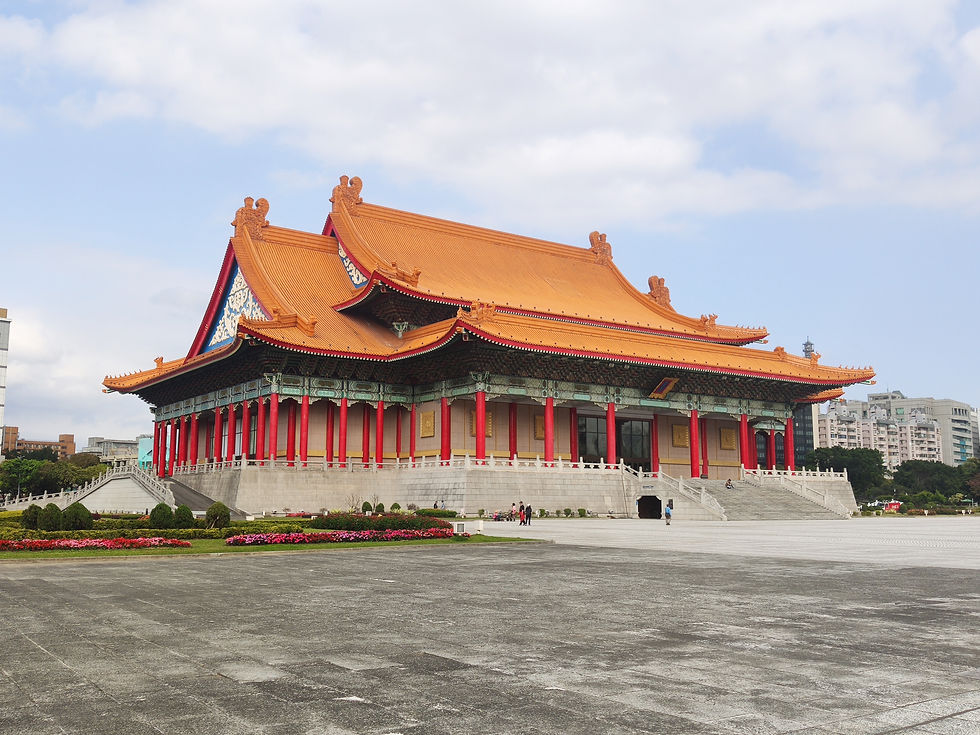
The authoritarian aesthetic was no mistake; Chiang established a one-party system in Taiwan and democratic elections only started in the 1990s. Under his rule, tens of thousands of Taiwanese were executed, imprisoned, or disappeared for being "bandit spies" in service of the Chinese Communist Party and opposition was fiercely stamped out. It's ironic, then, that the path beneath the shrine was renamed Democracy Boulevard and the square Liberty Plaza. Climb the 89 steps (one for each year of Chiang's life) leading up from the exhibit about his life and the irony becomes even more palpable. A 15-foot tall bronze Chiang smiles down at visitors, flanked on either side by a Taiwanese flag and an honor guard in immaculate dress uniforms. It's a strange place, a metaphor for the democratic transformation Taiwan has undergone in the space of a few short decades.


Surprise Ingredients and (Almost) Japanese Trains
Every city and town in Taiwan has one or more night markets, known to tourists as Chinese street food galore. We set our sights on the Shilin Night Market, Taipei's largest. There were dozens of stalls selling Taiwanese specialties; the selection was almost overwhelming. We had hujiao bing (delicious buns baked over a flame and filled with meat and black pepper), pickled durian, and tang hu lu (candied strawberries). Bubble tea, which I had been drinking since arriving in Asia, was apparently a Taiwanese invention, and is made in dozens of versions with water, milk, or cream. We went to a popular place near the market but I didn't think it was any better than in Vietnam. The most unforgettable dish, though, was zhu xie gau, which my phone translated as rice cakes coated with peanut flour. The taste was mediocre and the color was a surprising brown; only later did I make the nauseating discovery that the translation neglected to mention it was made with pig's blood. What a way to get acquainted with Chinese street food.

An early-morning train took us out of Taipei and 100 miles down the east coast of the island to the city of Hualien. The train was Japanese-built, evidenced by the short car doorways I banged my head on, which seemed unsuitable for Taiwan, where people are actually remarkably tall. The ride was comfortable, punctual, and quick, and the railway itself a marvel of engineering with tunnels cutting through dramatic coastal mountains, but after Japan it didn't seem that impressive. What even the Japanese didn't do, though, is dig rail tunnels through the city, eliminating the scar on the urban landscape made by train tracks, power lines, and bridges. The intercity trains run parallel to a subway line until climbing to street level in the city's outskirts. As a result, while the area surrounding the main station in Taipei isn't pleasant, with wide avenues clogged with buses and a maze of traffic lights, at least it's an uninterrupted space integrated with the rest of the downtown, unlike most Western cities.

The second we stepped out of the station we heard an unexpected familiar sound as a flight of F-16s flew right over our heads and came in to land not a mile away from us. This was the first proper military presence I had seen in Taiwan, which was a lot less militarized than I had expected it to be, considering its somewhat precarious tactical situation. Sure, there had been army trucks driving around here and there, but that was about it. I had expected anti-tank barriers by the highways, coastal artillery near the capital, and a sense of impending doom, but maybe I was being too Israeli. Thankfully, the Republic of China Air Force seemed to confine its flights to daylight hours, so the roaring jets didn't bother us at night.
On Two Wheels Again
The reason people come to Hualien is for the wild nature of the sparsely populated east coast. More specifically, the Taroko Gorge National Park, centered around a dramatic mountain valley of the same name descending over 3,000 meters from the center of the island to the coast just north of Hualien. We rented bikes and rode to the park entrance, a pleasant half hour on good roads with dedicated lanes for those on two wheels.
Near the mouth of the valley was the Shakadang Trail, a scenic 4.5 kilometer hike tracing a side valley with a stream of bright turquoise water. The path, which in many parts was carved out of the mountainside, was actually built by the Japanese colonial administration to access a hydroelectric dam they had built upstream. Normally very popular with domestic tourists, we had the path nearly to ourselves.

We continued up Highway 9, the road built up the gorge at the cost of 223 lives according to a roadside memorial. At least they didn't seem to be slave-children like in Vietnam. The scenery was incredible and the road was in perfect condition, but the skies were rather gray and threatening serious rain. We suddenly reached a traffic jam of several dozen cars at a standstill; creeping forward we saw the road was closed due to construction. It seemed it had been closed for a while and we considered turning around, but thankfully the woman manning the roadblock spoke enough English to tell us the road would open in 10 minutes.

Further up, the road passed by some isolated temples until it stopped following the river canyon and became a very twisty mountain pass. Having gained over 700 meters of elevation, the wind had picked up and became very cold, the sun was beginning to set behind the mountains, and pushing on would have required another entire hour due to the road only opening at the top of each hour, so we turned back with heavy hearts, having missed out on the most spectacular scenery at the top of the pass. We stopped at a few spots along the way back down, including a pedestrian suspension bridge high enough across the gorge to make a rock climber's head spin. It was like being back in Vietnam, only with a slower bike and better roads.

Hualien had a night market, too, where we had mochi, which were actual rice cakes in peanut flour, and stinky tofu, a Taiwanese specialty. The dish is made by fermenting tofu, frying it, and dipping it in a soy-based sauce. The fermented tofu gives off a smell not unlike blue cheese, and every blog post I had read about traveling in Taiwan had recommended to try it. The smell made it hard to enjoy the flavor, which wasn't even good in my opinion, and the aftertaste only disappeared after 3 sticks of spearmint gum. I won't be trying that again anytime soon.

The Day I Became a Chinese Tourist
Our hostel was advertising a full-day tour of the park to places we hadn't visited so we booked it for the following day. We got picked up in a minibus the following day, with a distinct feeling that something was off, since we were the only non-Asians aboard and the driver's English seemed to be limited to "thank you" and "welcome Taiwan". Our suspicions were confirmed once we left the city and the driver started yapping away in Chinese over the PA system, one hand on the wheel and another on the mic, somehow managing to shift gears with hardly a pause for air. Planning this trip, I had heard countless horror stories of Chinese tour groups bussing around from one attraction to the next with microphone-equipped guides ruining the peace, and now an unexpected plot twist had caused me to join their ranks. Thankfully, two of the other passengers spoke English and would tell us how much time we had at each stop. One of them was visiting his Taiwanese girlfriend from his home country of Thailand, and had a very impressive life story - he had gone to high school in Singapore against the wishes of his parents to learn Chinese and then spent a few years in Australia to improve his English, making him fluent in three languages from three different families using three different scripts.

Even without understanding a word of what was being explained, the tour was pleasant, taking us to spots we hadn't seen the previous day on our own to admire the canyon scenery. The day had started off very rainy, but the driver didn't want to take chances further up the road and deviated from the plan after lunch to match the weather conditions. Unfortunately for us, he decided to go to nowhere else but the Shakadang Trail, which we didn't feel like hiking for the second time. Instead, we headed in the opposite direction down the valley and found a scenic spot to make further travel plans.
We had booked a flight to Russia through Seoul giving us two weeks in Taiwan, but both legs of the flight had been cancelled for reasons I'm sure you can figure out on your own by now. The situation seemed to be worsening by the day, with a growing list of travel restrictions around the world, many of which included people with a recent history of visiting Japan. Yotam only had an Israeli passport, seriously limiting my already slim options unless we decided to part ways. Malaysia, Indonesia, the US and its Pacific possessions, Australia, and New Zealand weren't options for an Israeli, China and Korea were off-limits, and Thailand and India had recently introduced mandatory quarantine for anyone coming from Japan. Roy and Peleg had luckily missed the cutoff by one day, but Peleg then flew onwards to India only to discover he could either spend his entire two weeks there in quarantine or fly home to Israel (where a similar prospect awaited him). Things weren't looking great and time was running out to make a decision, with the prospect of quarantine in a foreign country becoming more likely with each passing day.

Back on the bus with the Mandarin soundtrack, we drove to Qixingtan, a rocky beach south of the park. There was a strong Pacific wind blowing, serving to intensify the dramatic setting. Waves almost 10 feet high came crashing onto the black rocks, the steep green mountains of the national park visible past bright turquoise water. The bigger wave sent tongues of foam shooting up the beach, which was surprisingly warm to the touch considering how cold the wind was. I was so focused on taking pictures of the waves that a particularly large one soaked me nearly to my knees, making my pants and socks as salty as my jacket.
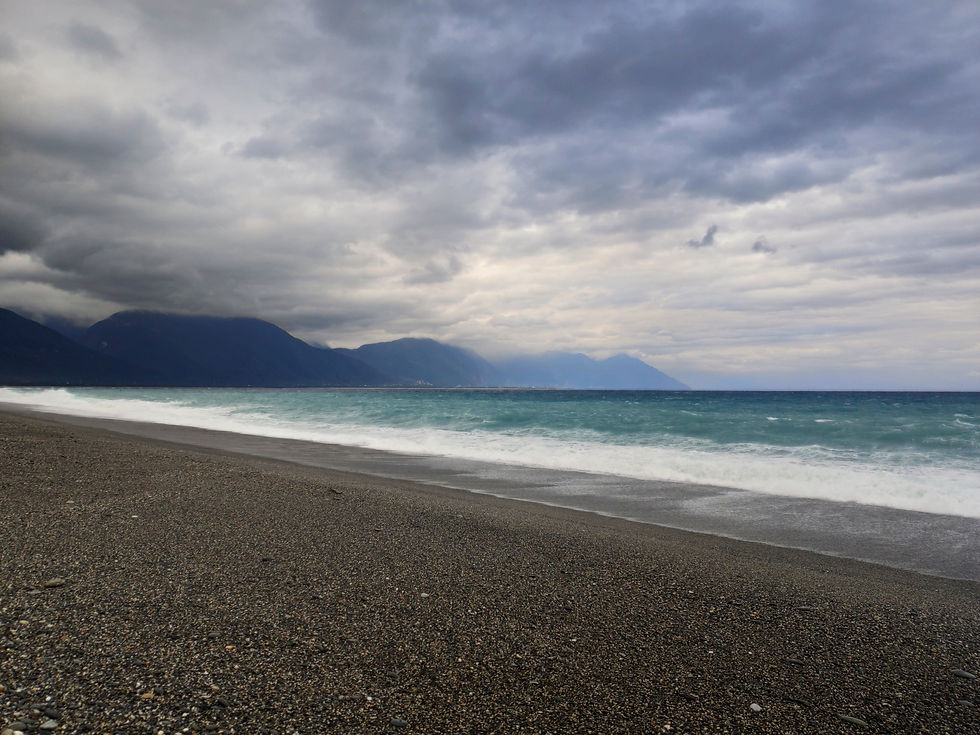
After a proper shower, we got our hair cut by a girl in a miniskirt who looked about 15 and spoke zero English. The results were better than in Tokyo and we paid less than a tenth of what we had paid there. They even had the vacuum cleaner for the hair, though it wasn't as good as in Japan. The hostel receptionist had recommended a place for dinner where we could get beef noodle soup, one of Taiwan's most famous dishes. A look at the menu revealed they also had cha ye dan, eggs boiled in a broth containing tea and spices, which were as delicious as I had expected them to be. Other items on the menu included duck and pig blood jelly, spicy chicken feet, and pork ears, but we stuck to the beef noodle soup, which was unfortunately rather uninspiring.

Back to the Capital
If I substituted Japan and Taiwan for China, the trip should have continued in Mongolia towards the end of March, followed by Russia at the beginning of April. Russia had all but closed its border with Mongolia, meaning we had to make other plans (again!). After giving our options serious thought, including earnestly considering diverting our trip to South America (the 46-hour, 22,500 kilometer trip to southern Chile was less than $1000 in these crazy times), we decided to go straight to Russia, starting in Vladivostok on the Pacific coast instead of Ulan-Ude, over 2,000 kilometers to the northwest. Wary of tightening border controls, especially for people with Japanese and Taiwanese stamps in their passports, we decided the most prudent move would be to move our flight up as much as possible in an effort to beat likely future restrictions. Our original flight had conveniently been cancelled, so we booked a new one through Tokyo for Sunday morning, only two full days away.
With our time in Taiwan newly limited, we decided to spend the remaining days in Taipei. The Thai-Taiwanese couple from the tour had recommended a place to try traditional Taiwanese breakfast, which consisted of dan bing (crepes filled with egg and other toppings) and dou jiang, a soy-based drink served either hot or cold. The crepes were delicious (what was not to like?), but the soy milk was literally undrinkable, leaving an aftertaste well into the train ride to Taipei.

Back in the capital, we checked into a hostel literally a block away from our previous accommodation. Taiwan was a convenience store country almost as much as Japan was, only with more cooked food in the stores. After reading a great blog post about the best 7-Eleven foods in the country, we decided to give it a try. Sitting in the store's small eating area, we had baozi (steamed dumplings filled with meat), tea eggs, and onigiri, which wasn't Taiwanese but was almost as good as the Japanese original. It was actually delicious and very fresh, not a bad lunch for $3.
We got on a bus to cross the city towards the National Palace Museum. Besides the soundtrack of non-stop announcements we had already gotten used to in Japan (though Chinese was definitely less easy on the ears), the bus had the loudest manual transmission I've ever heard. Every gear change sounded like it might be the last, every station departure like a car being shredded, but I seemed to be the only one flinching. It was bizzare, considering how technologically advanced Taiwan was, and made me understand why automatic transmissions had initially been developed for tanks.
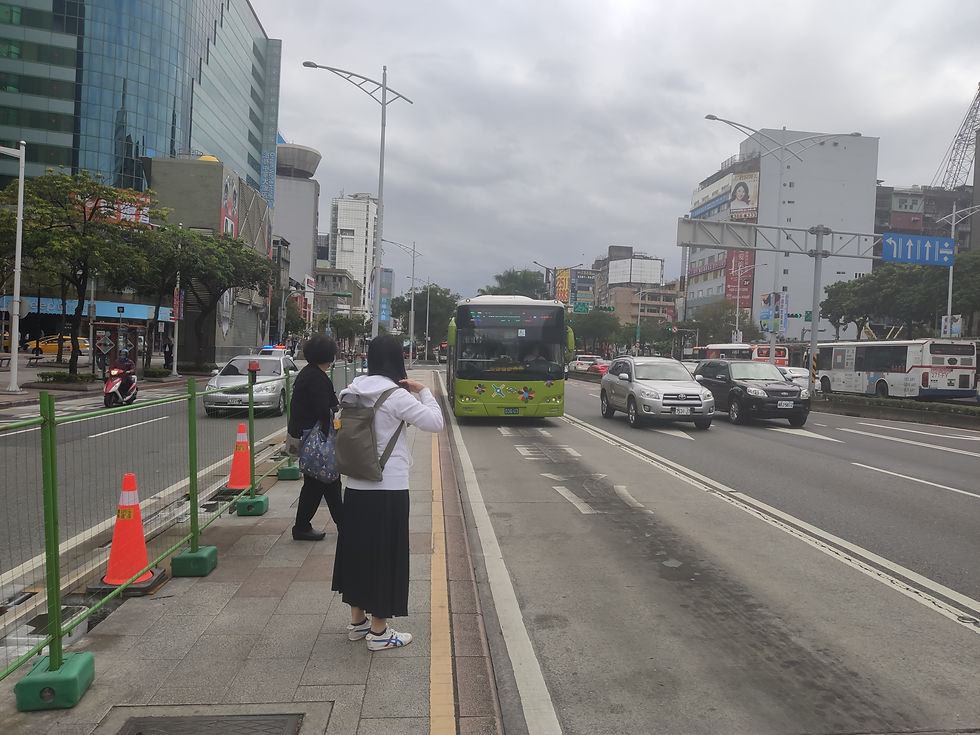
Before the Nationalists made their retreat to Taiwan, they packed up thousands of China's most important cultural and historical artifacts to take with them. The National Palace Museum, formerly in Beijing, was reopened in Taipei with an unparalleled collection of Chinese pottery, manuscripts, and artwork, mainly from the Qing Dynasty, which ruled China from the 17th century until the Nationalists seized power in 1911. These were things I knew very little about, but the museum did a decent job explaining most of it and some of the artifacts were truly magnificent objets d'art. The Jadeite Cabbage, the museum's most famous work, was unfortunately on loan, but there was plenty to admire.
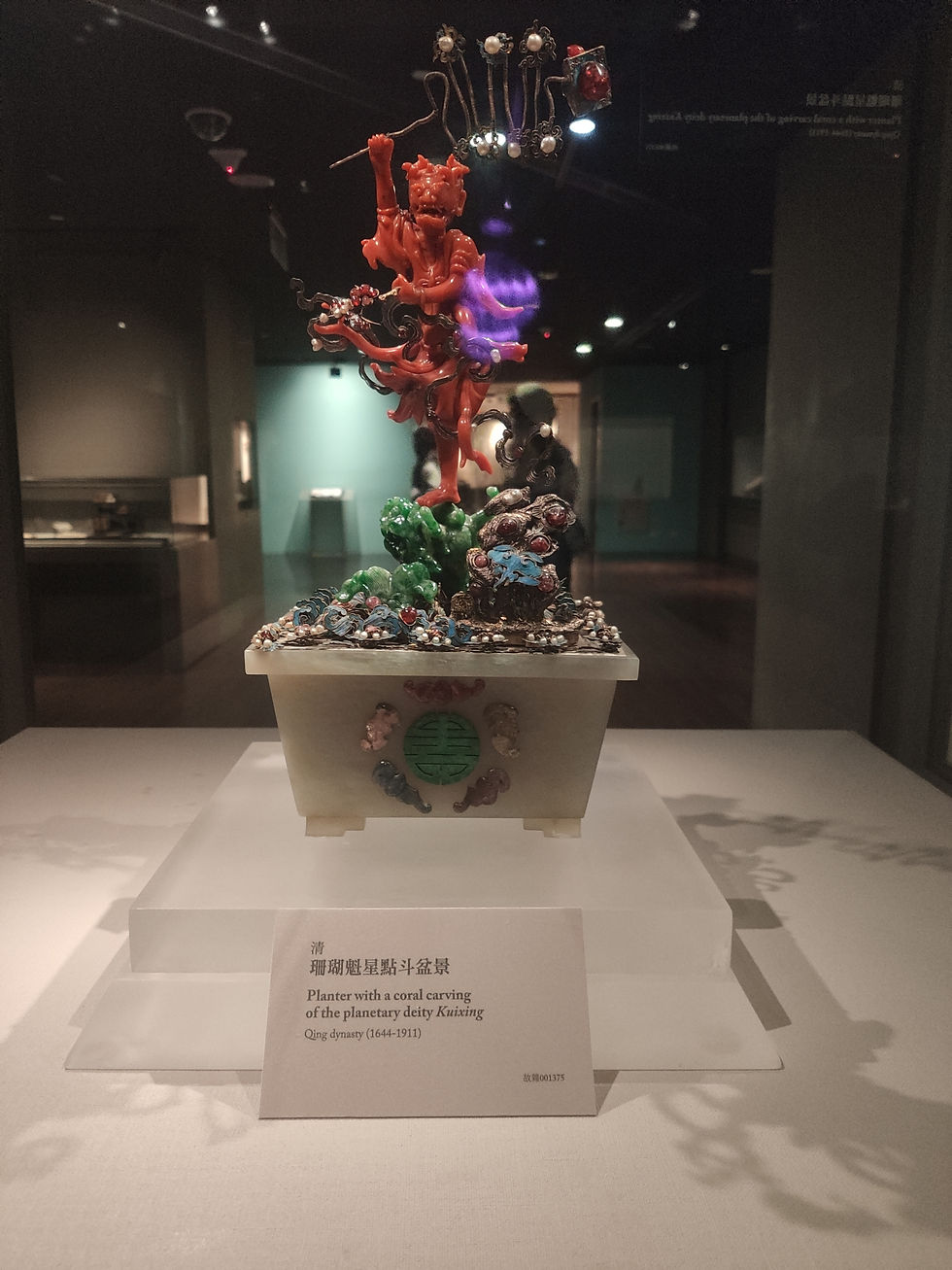
Club Thermometers and Patriotic Dancers
Taipei was supposed to have a clubbing scene on par with Tokyo and we were happy to be back on a weekend and see if it were true. This was becoming a familiar weekend rhythm - finish touring early, have some drinks at the hostel, party until the early morning - but it seemed this wouldn't be the final episode for a while. We finished some shōchū I had brought from Japan and took the subway out to Xinyi, Taipei's business district. It was funny this was our first time in one of the most touristy areas of the city, with fancy shopping malls and the world-famous Taipei 101 tower, formerly the tallest in the world, but it was also the busiest nightlife area.
We picked a club that had received high praise online and waited online for nearly an hour as they let people in at a trickle, but they had a waitress giving out cocktail shots to pass the time more quickly. Near the end of the line we had our temperature taken, which was definitely a first for both of us.
Actually, we had had our temperature taken pretty much everywhere in Taiwan, which was dealing with the outbreak very seriously (and quite successfully). There were infrared cameras at the entrance to subway stations and museums, an ear thermometer checking in to the hostel in Taipei, even a laser thermometer at the mobile phone shop where we got local SIM cards.
Having passed the temperature test, we were escorted into a truck-sized elevator that took us up to the club on the eighth floor. Incredibly, our entry tickets got us access to an open bar all night, meaning it was going to be a long one. We immediately met Jules, a traveler from France, who was obviously a number of drinks ahead of us and took us to dance with a group of local friends. The music was good, the crowd was local and energetic, and the cocktails kept coming. The most over-the-top part was the dancers in flamboyant costumes who alternated dancing on stage and bringing bottles to VIP tables accompanied by a shirtless guy with a Taiwanese flag. Curiously, there was an electronic sign above the bar where between pictures of cocktails a warning sign would occasionally appear with a crossed-out shrimp on it. We danced until 2:30 with some friendly locals, the party still in full swing but the cocktail of exhaustion and alcohol had caught up with us. We started walking the 6.5 kilometers back to the hostel, but only made it about two before our legs couldn't take us any further. Taipei was another city lacking public transportation at night, although unlike Japan an Uber to take us the rest of the way wasn't expensive.
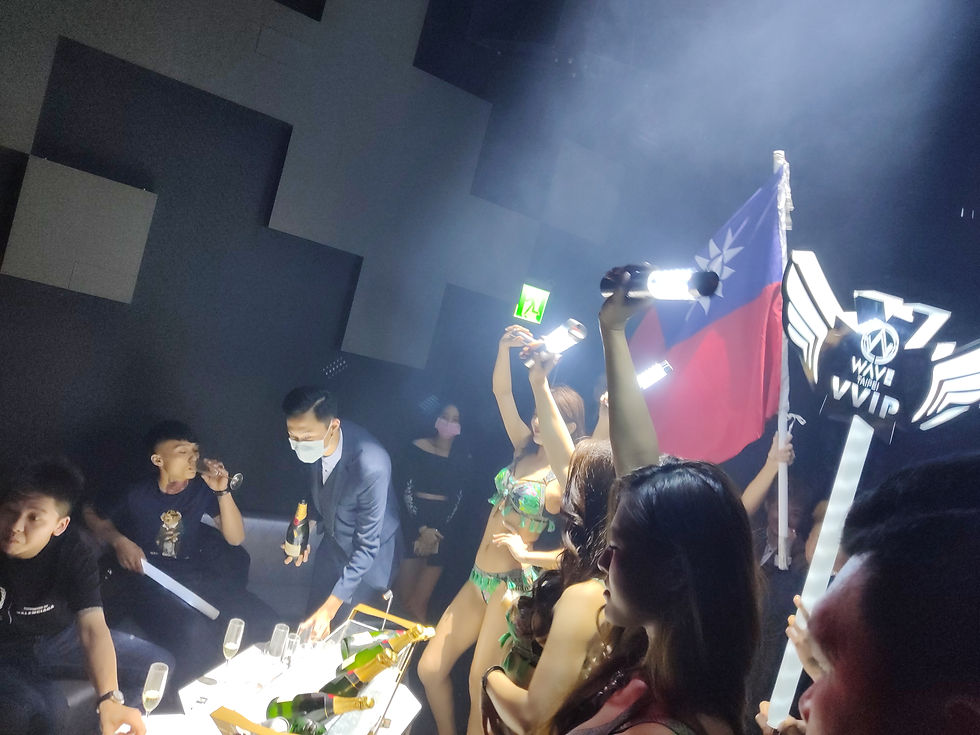

The next day was our last in Taiwan, an abrupt ending to this spontaneous detour. This time, we were not awakened by an oblivious housekeeper, and returned to Xinyi for the only Taiwanese Ichiran, our favorite Japanese ramen chain, but the wait was about an hour. Taipei had so much good food of its own, so we cut our losses and hopped on a bus to a place selling black pepper buns that had rave reviews. Unfortunately, the place turned out to be part of the night market and not open during the day, but there was another one next door that was delicious, too.

We returned to Xinyi once more to try and get a view of the city from above. Taipei 101 had an observation deck on the 89th floor, but tickets were expensive, so we headed to the Starbucks in the building, which located on the 35th floor has the title of the highest Starbucks in the world. What we wished we had known was that it was also the only Starbucks in the world requiring a reservation, even though I couldn't possibly imagine it was full with most of the tourists gone.
The rest of Xinyi was fun, though, sort of like a taste of Japan. There were huge digital billboards, shiny skyscrapers, and fancy department stores in a huge pedestrian complex surrounding Taipei 101. It might have been Taiwan's business hub, but on the weekend it was full of locals on outings, both young people and families.


It was getting hot, and the air in Taipei always seemed heavy, meaning it was time for some ice cream. Taipei has some unusual restaurants, one of which is bathroom-themed with the creative name Modern Toilet. The seats were shaped like toilets, the dishes were marketed as "crappy" and the food was either poop-shaped or came in a toilet. We ordered the crappy ice shavings, which was a giant toilet bowl filled with vanilla ice shavings and topped with different brown-colored things. It wasn't particularly tasty, but it ticked the box for weird local restaurants.
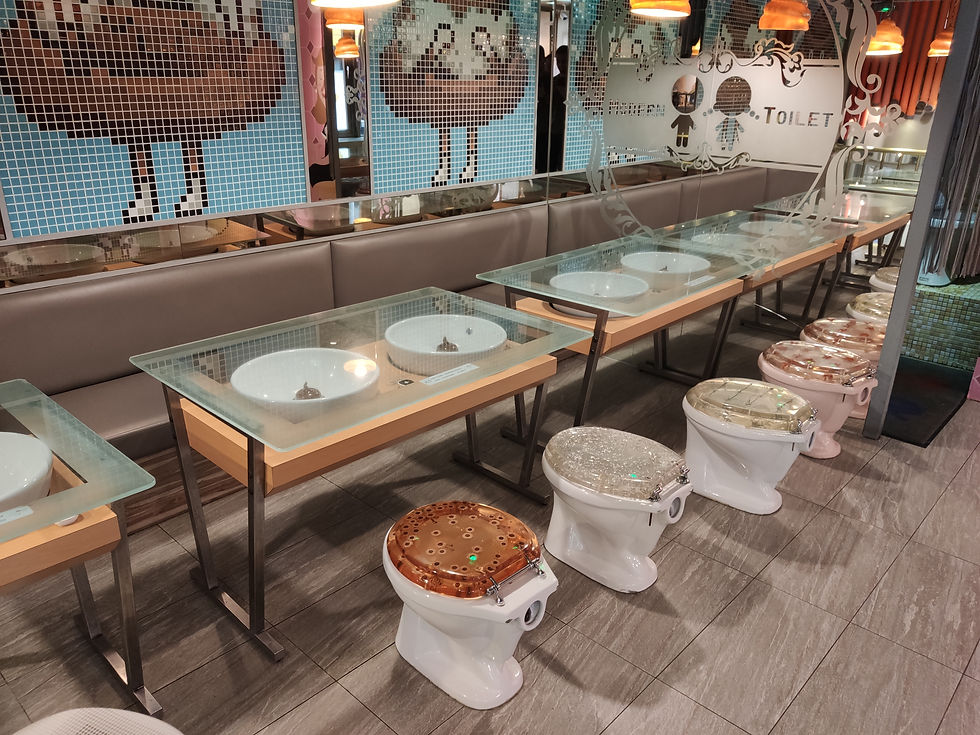
Our flight to Tokyo was scheduled for 6:40 am, so we were going to have an early night. Before that, though, I wanted to get rid of all the Taiwanese dollars I had taken out, thinking I would be in the country for much longer. This proved to be much more difficult than I could have imagined, since Taiwan has some byzantine regulations on foreign exchange. US dollars could only be had at banks, which were all closed until Monday morning, or a handful of official change bureaus located in department stores. I went to two different ones, but they could only GIVE Taiwanese dollars and told me to go to the 24/7 bank at the domestic airport. It was only 20 minutes on the subway and I had nearly US$100 in Taiwanese currency, which I didn't expect to be able to exchange anywhere this side of Moscow, so off I went. To top it off, the exchange rate was less than stellar so -10 points for Taiwan.
A few precious hours of sleep and another late-night bus ride landed us back at the airport, only 5 days after arriving in the country. The late hour had the terminal nearly empty, the departures board full of cancelled flights, and there were comfortable lounge chairs to sleep on after I spent my remaining local currency on snacks I expected to cherish in Russia.

The flight to Tokyo was on a Singaporean 787, the first one I had ever flown on, and virtually empty. The oddities of airline ticketing required us to check in from scratch to our connecting flight, so were stamped back in to Japan (actually it was a cute sticker of Mt Fuji) and took the shuttle bus between terminals, with the driver mumbling in Japanese into the PA the whole way. It was as if we had never left Japan and Taiwan had been a brief dream.

Attempting to check in to the Aeroflot flight to Vladivostok, the clerk asked to see our flight reservations out of Russia. We responded that we didn't have any, since we weren't sure when exactly we were leaving or from where, triggering the short-circuit reaction that seems to happen anytime the predicted script is deviated from with a service provider in Japan. The bigger the deviation, the higher the voltage, and this woman practically started to smoke. After telling us we might not be able to board the flight and asking us to book plane tickets right then and there, she pulled out a phone and had a conversation with some airline official in Japanese-accented Russian, which is one of the more amusing languages I've heard. In the end, we were made to sign a form releasing Aeroflot of any responsibility to return us to Japan in case we weren't allowed in and permitted to check in, with enough time for a trip to the duty-free 7-Eleven for some proper onigiri. Onwards to Russia!





Comentários